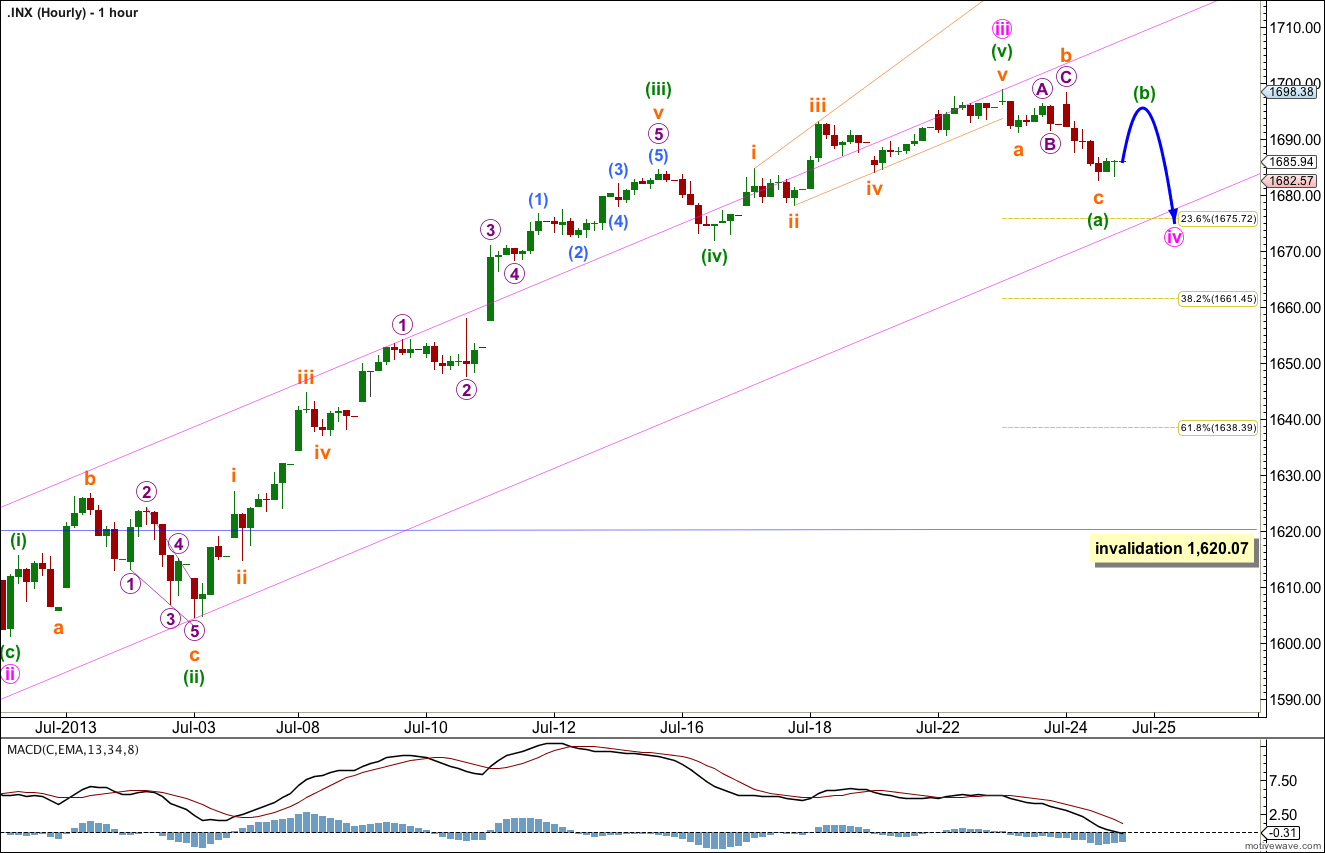The S&P 500 moved lower as yesterday’s analysis expected. The wave count remains the same.
I have two hourly charts for you today to cover the various possibilities of this correction.
Click on the charts below to enlarge.
This wave count agrees with MACD and has some nice Fibonacci ratios in price and Fibonacci relationships in time.
Minor wave 3 is 15.1 points longer than 2.618 the length of minor wave 1.
Ratios within minor wave 3 are: there is no Fibonacci ratio between minute waves iii and i, and minute wave v is 5.44 points longer than equality with minute wave iii.
At 1,740 intermediate wave (C) would reach equality with intermediate wave (A). At 1,739 minor wave 5 would reach 0.618 the length of minor wave 3.
Within minor wave 5 no second wave correction may move beyond the start of the first wave. This wave count is invalidated with movement below 1,560.33.
Minor wave 1 lasted a Fibonacci 21 days, minor wave 2 lasted a Fibonacci 8 days, minor wave 3 has no Fibonacci duration at 98 days, and minor wave 4 lasted 22 days, just one day longer than a Fibonacci 21.
At this stage minor wave 5 has lasted 21 sessions. The structure is incompelte, it is very unlikely to be over today. A further 13 sessions would see it ending in a Fibonacci 34. At that time I will look to see if the structure could be considered complete. If it can we shall have an alternate wave count to consider the possibility again of a trend change at cycle degree.
Keep drawing the wider parallel channels from the monthly chart and copy them over to the daily chart.
Main Hourly Wave Count.
So far to the downside we have a small shallow zigzag structure. I have checked the subdivisions on the five minute chart, and it subdivides 5-3-5.
Minute wave ii was a brief shallow 32% zigzag. We should expect to see alternation between minute waves ii and iv, so it is unlikely that minute wave iv is over already as a brief shallow 17% zigzag.
This may be minuette wave (a) of a flat or a triangle for minute wave iv.
It may also be the first zigzag of a double zigzag or double combination for minute wave iv. If this is the case it would be relabeled minuette wave (w).
If minute wave iv is unfolding as a flat correction then within it minuette wave (b) must reach 90% the length of minuette wave (a) at 1,697.16. Because a flat correction would be the most likely structure for minute wave iv it is likely that we shall see some upwards movement to 1,697.16 or above. Within a flat correction minuette wave (b) may make a new high above minuette wave (a) at 1,698.78.
If upwards movement fails to reach 1,697.16 or above then minute wave iv may be unfolding as a double zigzag, double combination or a triangle.
A double zigzag could be expected to take price a lot lower and could reach down to the 0.618 Fibonacci ratio at 1,638.39.
A double combination would move price sideways from here for another couple of days or so.
A triangle would move price sideways from here also for another couple of days or so. It may include a new price extreme above 1,698.78 if the triangle is a running triangle.
There remain several possibilities for minute wave iv at this stage. What is most likely is that it is not complete and should continue further either sideways or lower for about another two days.
Alternate Hourly Wave Count.
The guideline of alternation is a guideline and not a rule; it does not have to be adhered to for the wave count to be valid, and is just a guideline of what is most likely to happen.
It is possible that minute wave iv is over already as a brief shallow zigzag. The only alternation with minute wave ii may be in depth; minute wave ii was deeper at 32% than minute wave iv at 17%.
At 1,743 minute wave v would reach 0.618 the length of minute wave iii.
This possibility has a very low probability. It must be considered, but should only be taken seriously if the next upwards movement subdivides as a clear five and not a three.
Movement below 1,682.57 would invalidate this alternate as within minute wave v no second wave correction may move beyond the start of the first wave.




NYMO was under the lower BB line today at the open … http://scharts.co/16fDuo3 any dip under is a buy point setup // until we push in 1736